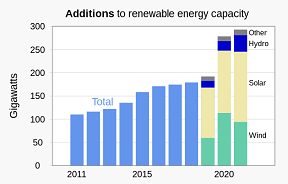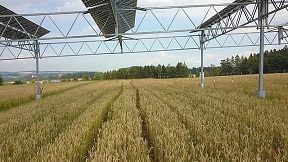The first assessment of solar and wind power performance over 2022 has been published, by independent climate think tank Ember. Both forms of energy production did very well. Together, they accounted for 12% of global electricity production, as opposed to 10% in 2021. Researchers say that this may herald ‘the beginning of the end of the fossil age’. But solar and wind still need to speed up. By 2030, they need to power 41% of global electricity; in order for electricity to reach net zero emissions in 2040. On the way to decarbonization of the entire energy sector by 2050. Or would area requirements by solar panels become an obstacle?

Solar PV fastest growing energy source
Clean electricity will reshape the global economy, from transport to industry and beyond, says the report’s lead author Małgorzata Wiatros-Motyka. For the 18th consecutive year, solar energy was the fastest growing source of electricity. In 2022 it volume rose by 24%. Wind energy grew by 17%. We are entering the clean power era, she said. The coal power phasedown will start to happen, she added. And the end of natural gas power growth is now in sight.
But still, the impressive growth of renewable sources was not enough to fulfil all of the world’s increasing electricity needs. The remaining gap was filled by fossil sources, driving up global emissions of CO2 to a new record high. But renewables are expected to meet the entire rise in electricity demand in 2023. No need to say that after this year, the pace of renewable generation growth still needs to step up in order to reach the world’s climate goals.

Area requirements by solar panels
What could stand in the way of this development? Economic forces indicate sustained growth at the present levels; fuelled by constantly falling prices. But area requirements by solar panels may prove to be too large, at least in densely populated (and consequently also energy intensive) regions. On this issue, Andrew Blakers and Ricardo Rüther wrote an article in PV Magazine. They start by pointing out that on a global scale, the issue of area requirements by solar panels hardly arises. If all energy were produced by solar energy, this would require at most 1% of all agricultural land. Regions with low energy consumption, or with substantial wind or hydro resources, would need much smaller areas of solar panels.
The most popular way to mount solar panels is on rooftops. But agreed, rooftop area is limited in size. In a few years, we will have equipped most rooftops with solar panels, at least in wealthy energy-intensive countries. But there are many more opportunities. We can build solar farms in such a way that they combine with agriculture (agrivoltaics); at least for crops that need to be protected from too much solar irradiation. We can build solar farms in arid areas, often non-cultivated. On inland lakes (hydropower or natural), and on calm maritime waters.
Areas that can be fitted with PV
These options may be somewhat more expensive than rooftop solar. For instance, agrivoltaics will require higher mounts than plain solar farms. And solar panels need to be spaced more apart. Floating PV is estimated to be 20% more expensive than rooftop solar. On the other hand, floating PV has a large potential. The authors mention the inland sea waters of Indonesia, where waves never reach heights above 4 m. And hydroelectric storage lakes; covering these with solar panels may result in an electricity production much higher than that of the hydropower plant itself. Needless to say, we will need to take care of electricity storage as well, if we continue to equip large areas with PV systems.
Still, rooftop PV is the fastest growing segment of the global energy market. But some countries, like Australia, might start thinking about what will come next. There, about one third of residential dwellings are already mounted with PV systems. These may first be repowered by more efficient solar panels. After all, their efficiency rises all the time. And batteries may store much energy.
Developing countries
In developing countries, electricity demand is typically much lower than in developed countries. In those countries the area requirements by solar panels will be lower and there will be much less area constraints. Therefore, these countries will generally not run into many obstacles in covering all energy demands by sustainable sources.
Interesting? Then also read:
A common sense or 50-50-40 energy scenario. Part 2: renewable energy
Ten times as much solar energy
Solar and wind energy: increasing recognition
